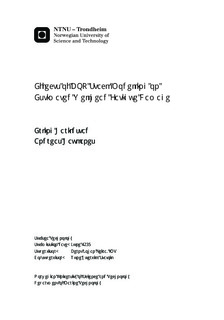| dc.description.abstract | To date, there are no international codes or standards that deal with estimation offatigue in subsea wellhead systems. Nevertheless have preliminary analytical methodsfor wellhead fatigue estimation been established. These analytical methods involve theuse of global dynamic response analyses. Such analyses are commonly carried out innite element software where the drilling system is modelled as beam or bar elements.Several uncertainties exist in regards to the mathematical modelling and simulationin global response analyses of drilling systems. In this thesis the uncertainties thatare related to the goodness of the representation of the blowout preventer stack (BOPstack), are addressed.An overview of previous and ongoing work on analytical estimation of wellhead fatigue isgiven. Relevant theory on the subject is presented and described. The theory comprisesof fatigue on structures, loads on a drilling system and static and dynamic responseanalysis. The main features of the preliminary analytical methods for estimating wellhead fatigue are summarized.The BOP stack is commonly assumed to have innitely high stiness when performinga global response analysis of a drilling system. The main objective in the thesis is toinvestigate if this is a good assumption. The investigation start with local modellingof an elastic beam element model of a BOP stack. Further, this elastic beam model iscalibrated to have the same stiness properties as a detailed 3D element model of theBOP stack. The calibrated elastic beam BOP stack model is implemented in a globalmodel of a drilling system. Global response analyses are carried out for two globalmodels. One with an innitely sti BOP stack model and one with the calibratedelastic BOP stack model. Fatigue damage estimates are calculated with basis in theresults from the global response analyses. The eects of BOP stack modelling areevaluated with regards to estimated fatigue damage in the wellhead. In addition to this main study, parameter studies and a sensitivity study are carried out to evaluateuncertainties and assumptions within a realistic frame.The results from the wellhead fatigue assessments conclude that the elastic BOP stackmodel imposes greater estimated fatigue damage in the wellhead compared to theinnitely sti BOP stack model. The dierence, in terms of estimated fatigue damage,imposed by the two BOP stack models is, at maximum, 0.51% for the main study. Thelargest dierence observed in the parameter studies is 1.34%. Hence, it is concluded thatthe eects of improved BOP stack modelling in a global response analysis, with respectto wellhead fatigue estimation, is not signicant. There are though some uncertaintiesconnected to the bending stiness of the wellhead connector and the LMRP connector. | nb_NO |

